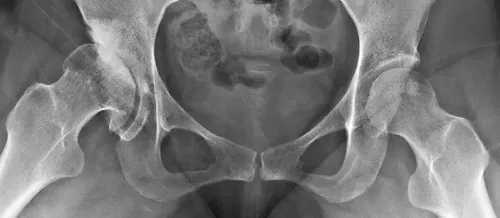Perthes Disease
"Age is one of the most important factors in relation to the final outcome. Children under 6 years old usually have a favorable course and an excellent final result".
DR. MATÍAS ALFONSO
SPECIALIST. ORTHOPEDIC SURGERY AND TRAUMATOLOGY DEPARTMENT

Perthes disease is a disease of the child's hip in which there is progressive weakness of the head of the femur and which can lead to permanent deformity of the head.
Children can experience hip pain and limping from many causes, from contusions from falls or sprains from bad gestures, to rheumatic inflammatory processes or infections.
In the exploration is usually seen discreet limitation of mobility of the affected hip.
Normally this disease is not related to falls or blows in the hip, although it is frequent that the parents suffer some problem in the hips or that the children take medication of steroids by other diseases, are obese or have had a period of fast growth.

What are the symptoms of Perthes disease?
The first manifestations of the disease are discomfort or pain in the hip, thigh or knee area, accompanied by a more or less pronounced limp.
Over time the child loses more and more mobility of the hip and his thigh may become thinner (muscle atrophy).
The most common symptoms are:
- Lameness.
- Pain in the hip area.
- Problems when walking.
Does your child have any of these symptoms?
You may have a Perthes disease
How is Perthes disease diagnosed?

After a physical examination of the child, X-rays of the hips should be taken.
Radiology depends on the evolutionary stage of the disease, the most characteristic images being the deformity and fragmentation of the femoral head, with alternating radiolucent and opaque areas.
Secondary lesions such as femoral neck augmentation and acetabular sclerosis can also be associated.
In the bone scan, an increase or decrease in isotope uptake can be observed.
How is Perthes disease treated?
During the initial phase there is usually pain and treatment with analgesics (aspirin, ibuprofen...) and rest is advisable.
In some patients with severe pain and great loss of movement of the hip may be necessary admission to a hospital to better control the rest and medication and even to place the legs in traction or place immobilizations. All this with the objective that there is no loss of mobility of the hip.
In serious cases and depending on the phase of the disease, a hip operation may be justified. The type of surgery can range from a simple lengthening of a groin muscle to major surgery of the hip to reshape the pelvis.
When this disease occurs in children older than 8-9 years, it is possible that malformations are left and significant hip arthrosis may appear, which may eventually require a hip prosthesis.
Where do we treat it?
IN NAVARRE AND MADRID
The Department of Orthopedic Surgery and Traumatology
of the Clínica Universidad de Navarra
The Department of Orthopedic Surgery and Traumatology covers the full spectrum of congenital or acquired conditions of the musculoskeletal system including trauma and its aftermath.
Since 1986, the Clinica Universidad de Navarra has had an excellent bank of osteotendinous tissue for bone grafting and offers the best therapeutic alternatives.
Organized in care units
- Hip and knee.
- Spine.
- Upper extremity.
- Pediatric orthopedics.
- Ankle and foot.
- Musculoskeletal tumors.

Why at the Clinica?
- Experts in arthroscopic surgery.
- Highly qualified professionals who perform pioneering techniques to solve traumatological injuries.
- One of the centers with the most experience in bone tumors.




















